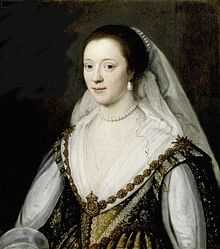Frances Coke, Viscountess Purbeck

Frances Coke, Viscountess Purbeck (1601–1645), was the sister-in-law of George Villiers, 1st Duke of Buckingham, and the central figure in a notorious sex scandal within the English aristocracy of the early 17th century that was known at the time as “the Lady Purbeck’s business”.[1] She was the younger daughter of the judge and privy councillor Sir Edward Coke and his second wife Lady Elizabeth Hatton. In 1617, her father betrothed her against her will to Sir John Villiers, 1st Viscount Purbeck, older brother of the Duke of Buckingham, the favourite of King James VI and I, in an apparent bid by him to win back royal favour after his dismissal as Lord Chief Justice and from the Privy Council.
Both Frances and her mother strongly opposed the marriage and they fled from London in an attempt to go into hiding at Oatlands. However, Coke obtained a warrant and with an escort of armed retainers carried his daughter back to London by force. Here, it was rumoured, she was “tyed to the Bed-Poste and severely whipped into consent”.[2] In September 1617, she was married to Viscount Purbeck at Hampton Court in the presence of the King and Queen. But the marriage was an unhappy one. Her husband was said to suffer from bouts of insanity and to withhold money from his wife and in 1621 the pair separated.
In October 1624, Frances gave birth to a son who was baptised as Robert Wright and rumours began that the child’s father was Sir Robert Howard, a son of the Earl of Suffolk. In January 1625, King James signed a warrant for the trial for adultery of the couple in the ecclesiastical Court of High Commission. However, as her biographer points out, “The prosecution of Lady Purbeck was pretty clearly at the instigation of Buckingham and not of Purbeck.”[3] In fact, the Duke seems to have become obsessed with his sister-in-law’s behaviour and appears to have accused her not only of adultery but also of witchcraft. In February 1625, he urged the Lord Chief Justice to imprison both her and Sir Robert Howard. Howard was confined in the Fleet Prison and Frances put under house arrest at the home of a London alderman. In March 1625, Howard was publicly excommunicated after he refused to answer to the charge against him and the proceedings were suspended.
The trial resumed in November 1627 under Archbishop Laud and Frances was convicted of "incontinency", or adultery. But she failed to perform her penance of standing barefoot in a white sheet in church and was again put under house arrest. She escaped by disguising herself as a page-boy and fled from London to France where she lived in exile in Paris for several years with her son. She converted to Roman Catholicism and lodged for a time in a convent although she did not become a nun. Eventually she returned to England where she died at Oxford at the Court of King Charles I of England in May 1645 at the age of about 44. She is buried in the University Church of St Mary the Virgin.
The dramatist Ben Jonson compared Lady Purbeck in his masque The Gypsies Metamorphosed (1621) to Venus, the “Queen of Love”, in which he wrote:
You shall turn all hearts to tinder,
And shall make the world one cinder.[1]
- ^ The Works of Ben Jonson, ed. W. Gifford (9 vols, London, 1816), vol. 7, Masques at Court, p. 390. Retrieved 11 February 2014.
During her exile in Paris, Sir Kenelm Digby wrote of her: “I have not seen more prudence, sweetnesse, goodnesse, honor and bravery shewed by any woman that I know, than this unfortunate lady sheweth she hath a rich stock of. Besides her natural endowments, doubtless her afflictions add much; or rather have polished, refined and heightened what nature gave her.”[4] Arthur Wilson, the early historian of the reign of King James VI and I, wrote in 1653 that she was “a Lady of transcending beauty, but accused for wantonness".[5]
References
- ↑ John Chamberlain to Sir Dudley Carleton, London, 23 March 1625, in Thomas Birch (ed.), The Court and Times of James the First (2 vols, London, 1848), vol. II, p. 508. Retrieved 11 February 2014.
- ↑ Thomas Longueville, The Curious Case of Lady Purbeck: A Scandal of the XVIIth Century (London, 1909), p. 54. Retrieved 11 February 2014.
- ↑ The Curious Case of Lady Purbeck, p. 87.
- ↑ The Curious Case of Lady Purbeck, p. 141.
- ↑ Arthur Wilson, The History of Great Britain, being the Life and Reign of King James the First (London, 1653), p. 147.